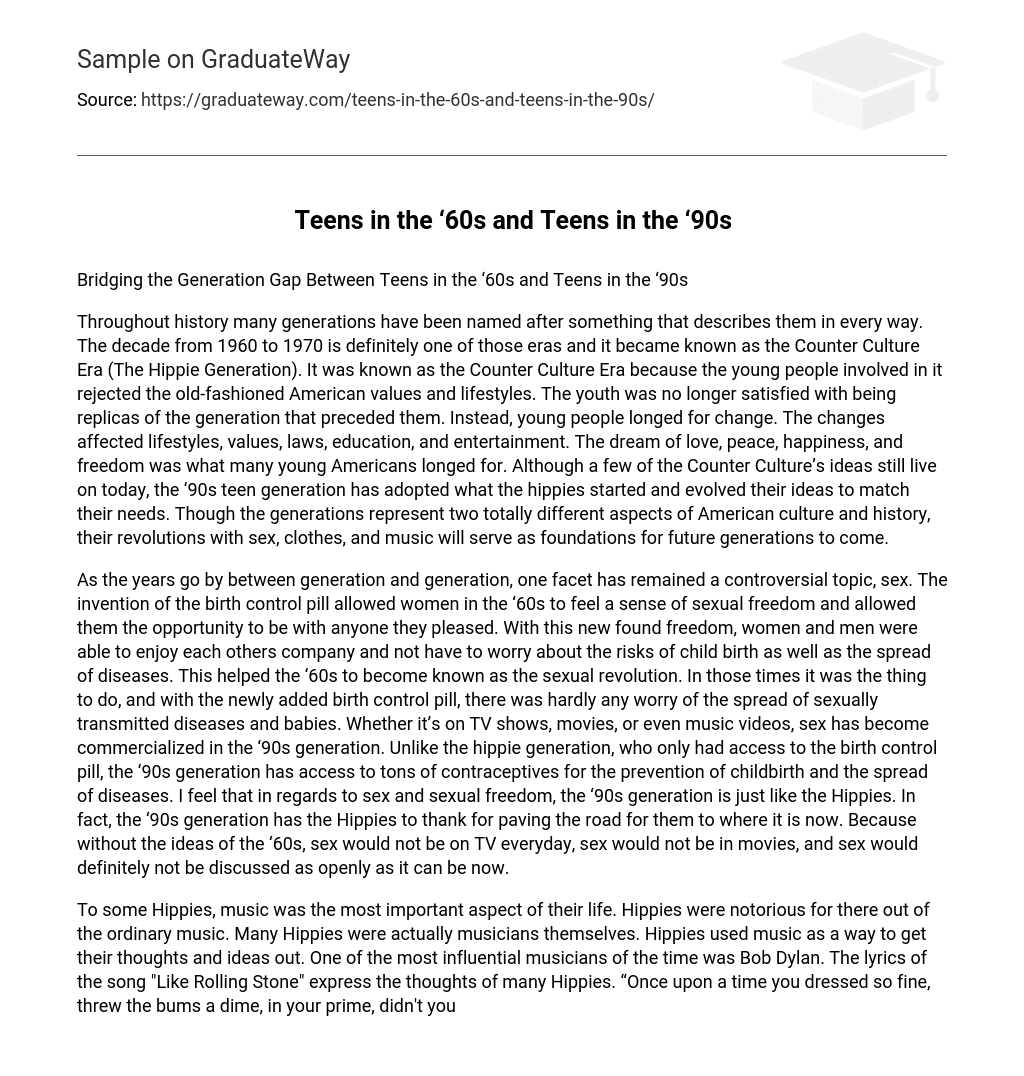Throughout history, numerous generations have been given names that perfectly characterize their essence. One such era is the decade spanning from 1960 to 1970, commonly referred to as the Counter Culture Era or The Hippie Generation. This particular era earned its name due to the rebellious nature of the young individuals involved, as they vehemently disapproved of traditional American values and lifestyles.
The younger generation no longer wanted to imitate their elders, but instead sought change which affected different aspects of life including lifestyles, values, laws, education, and entertainment. Numerous young Americans desired a dream of love, peace, happiness, and freedom. Although some ideas from the Counter Culture still exist today, the teenage generation of the 90s has adopted and adjusted hippie-originated ideas to fit their own requirements. Despite the significant differences in American culture and history between these generations, their revolutions regarding sex, fashion, and music will establish the basis for future generations.
Throughout generations, sex has always been a contentious subject. Nevertheless, in the 1960s, the advent of birth control pills granted women greater sexual autonomy and the ability to select their partners without constraint. This advancement not only alleviated worries about pregnancy and sexually transmitted infections but also cultivated an era characterized by intimate connections, leading to the designation of this time as the “sexual revolution.”
During earlier times, sexual activity was widespread and the worries about sexually transmitted diseases or unintended pregnancies were low due to the availability of birth control pills. The 90s generation experienced a rise in the commodification of sex through various media channels such as TV shows, movies, and music videos. In contrast to individuals from the hippie period who had restricted access to birth control pills, those belonging to the 90s generation had numerous contraceptive alternatives at their disposal for avoiding pregnancies and safeguarding against diseases.
The ‘90s generation, similar to the Hippies of the ‘60s, is indebted to the sexual freedom and expression of that era. The influence of the Hippie movement has resulted in sex being prominently portrayed on TV and in movies, and it has also become a subject openly discussed.
Music held great significance for certain Hippies, who were known for their unconventional musical tastes. Many of these individuals were also talented musicians. Music provided a platform for Hippies to convey and exchange their beliefs and concepts. Bob Dylan, an immensely influential artist during that period, captured the feelings of numerous Hippies with his song “Like Rolling Stone.” The song’s lyrics reminisce about a time when one was self-assured and benevolent but now appears more subdued and less arrogant.
Bob Dylan’s lyrics, “How does it feel, to be without a home, a complete unknown? With no direction home, just like a Rolling Stone,” reflected his personal experiences and observations. His direct but profound lyrics significantly contributed to his widespread fame and achievement. Dylan was frequently seen as a spokesperson for the ideals of numerous Hippies.
According to a critic from the New York Times, in the 1960s, Jimi Hendrix and Janis Joplin were renowned as “the king and queen of gloriously self-expressive music.” Similarly, in the 1990s, there were also notable musical icons such as Wu-Tang Clan, N.W.A, Tupac, and The Notorious B.I.G. However, what sets these groups apart from their counterparts in the 1960s is the genre they represent. While rock and roll dominated during the sixties, hip-hop and rap emerged as the defining genres of the nineties. These controversial genres serve as powerful symbols that encompass and define their respective generations.
The Hippies rejected traditional lifestyles and expressed this through their unique attire. They donned various clothing pieces including patched and ripped blue jeans, funky dresses, beaded headbands, fringed jackets, ragged T-shirts, shirts constructed from scrap material, and mod boots or sandals. Some Hippies even opted to go without shoes. Faded and dusty bell-bottom jeans constituted the core of their wardrobe. Conversely, the ‘90s generation embraces fashion without using clothing as a tool to defy traditional lifestyles.
During the ‘90s, teenagers were focused on their looks and chose to wear clothes that they found both appealing and comfortable. Although they would don different brands like Gap and Kenneth Cole, there was a noticeable resurgence in the popularity of the classic hippie fashion among young individuals. This clearly shows that regardless of a style’s age or lack of appeal, it will eventually resurface and regain popularity among the youth.
During the 1960’s, a group known as the hippies created a stir in America with their unique lifestyle and unconventional beliefs. These young individuals embraced life to the fullest, using illegal drugs and embracing rock and roll music. Their alternative practices and beliefs left America’s traditional middle class bewildered.
Despite being primarily concerned with protesting the Vietnam War and civil rights, the Hippie movement had a significant impact on both America and the world. Even in contemporary times, we can still feel the effects of their contributions. They achieved significant advancements and established important precedents that continue to shape the younger generation.





